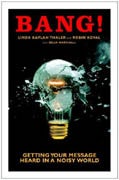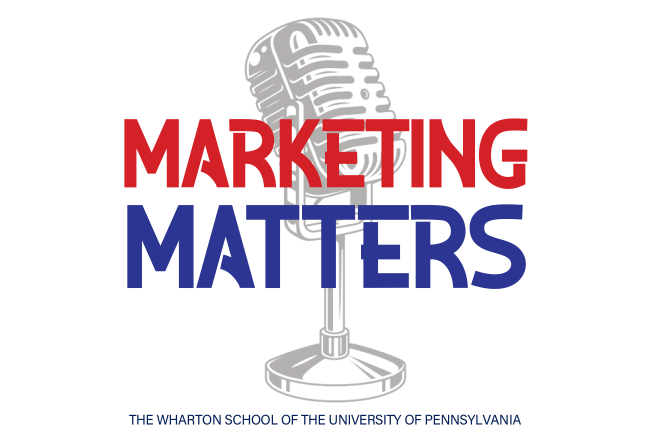AFLAC – an acronym for American Family Life Assurance Company – was an international insurance company with very low-name recognition until a duck began quacking its name on TV.
In a new book entitled, Bang! Getting Your Message Heard in a Noisy World, Linda Kaplan Thaler, CEO of the six-year-old New York advertising agency Kaplan Thaler Group, contends that only ideas that are “simply too outrageous, too different, too polarizing to go unnoticed” will break through the “sea of sameness out there.”
Like, say, a spokesduck.
Bang! is a book of advice on how to spur imaginative thinking and successfully carry out a creative idea after it arrives. The advice is interwoven with quotes from authors of books on creativity and related subjects, and, more entertainingly, with the stories of dozens of advertising campaigns.
The book’s cover lists the authors as Thaler and Robin Koval, chief marketing officer of KTG, “with” writer Delia Marshall, but the advice and the stories are told in the first person as if by Thaler alone.
It was Thaler who, in 1999, received a voice mail message that led to what has become her agency’s best-known ad campaign. “AFLAC? Never heard of it,” she recalls thinking. “Probably some itty-bitty local company needing help with a print ad or something.”
Didn’t sound interesting, but it is Kaplan Thaler Group policy (which Thaler recommends) to always politely call back. It turned out that AFLAC is a successful Fortune 500 company specializing in supplementary insurance to fill gaps in health insurance such as loss of earnings in cases of catastrophic illness or injury. Its agents deal mainly with employers who offer the insurance as a benefit. And although the company had spent $100 million on advertising in previous years, says Thaler, “no one had ever heard of them.”
KTG took the account on even though, she says, “aside from renaming the company ‘Tide’, we didn’t have a clue how to make AFLAC a household name.” But they brainstormed ideas. They came up with sentimental commercials, with possible celebrity endorsements, with “all sorts of stuff.” But none was what Thaler calls a “Big Bang.”
Love a Duck
Then, at lunchtime, creative team member Eric David went outside and began walking around the block saying “AFLAC” over and over in his head. Finally, he said it aloud …and realized he sounded like a duck.
That led “five minutes later” to an ad in which two men sit on a park bench throwing bread crumbs toward some nearby ducks. One man says how glad he was to have had supplemental insurance when he got hurt and missed work. The other asks: “supplemental insurance? What’s that?” One of the ducks replies, “AFLAC.” As the men continue to talk about the insurance but fail to come up with the name of the company, the duck keeps trying to help but is ignored. Finally, the duck is so frustrated, it kicks a bread crumb back toward the bench.
Not everybody at the agency saw this duck as a winner. Were they really going to suggest this ad to a company that sells cancer insurance? They were. They did. And, according to Thaler, AFLAC sales have risen 55% since the duck ads began.
It was risky to inject humor into ads for a company with such a serious product. But Thaler insists that you have to take risks if you want to produce a big bang. “Big Bang ideas are “intentionally polarizing,” she writes. “If you have an idea that no one hates, everyone will forget it. She points out that no one dislikes vanilla ice cream, but they don’t get excited about it either.
Thaler was working for Wells, Rich, Greene in 1994 when she was asked to create a campaign for Clairol’s Herbal Essence shampoo, a brand that Clairol was considering pulling from the shelves. Thaler says she knew the usual photos of models with gorgeous hair wouldn’t help.
The account planner suggested maybe there was a reason to use shampoo other than getting one’s hair clean. That led to asking women at the agency how they felt about shampooing. Some said it was boring. But some said they found that massaging their scalp under a hot shower was a revitalizing and sensual experience. That led to scripts of women diving into waterfalls and women dancing in the shower but no big bang.
The big bang came, says Thaler, when she and two staffers met to moan over their lack of success. They talked about maybe bringing in a celebrity like actress Meg Ryan. They recalled the famous scene in the movie When Harry Met Sally in which Meg Ryan feigns an orgasm in a coffee shop. The upshot was a commercial featuring a woman in a shower reaching an ecstatic climax from shampooing. A couple is seen watching this on their TV set and the woman says: “I want the shampoo she’s using.”
Many people thought the commercial was in outrageously bad taste. But Herbal Essence sales soared, says Thaler.
Being willing to be outrageous is just one bit of Thaler advice.
She also advises having work done in a crowded office. She contends that people are more creative when they work in such close contact because they are constantly communicating. “Only when you get to the point where you can’t answer the phone without knocking someone’s coffee on the floor” should you consider moving to larger quarters, she says.
According to Thaler, the best ideas come when a deadline is fast approaching. (The AFLAC idea arrived as panic time approached). And so she suggests creating artificial deadlines if the real ones are far away. She says she is famous for saying: “We’ve got nothing. It’s terrible,” just to get people thinking in last-minute mode.
Thaler is a big booster of brain-storming with others, holding nothing back. “Great ideas come out of boring ones,” she says, noting that one person’s bad idea can jump start another’s big bang.
Chaos Theory
But although Thaler favors “chaos” as a stimulator of ideas, she makes it clear that KTG is anything but chaotic when it comes to carrying out an ad campaign. A big bang is just the beginning, she says. “It has to be followed by unwavering attention to detail.” For example, two different actors quack for the duck in the AFLAC ads – one when the duck is calm, the other when the duck is annoyed.
She notes that to sell an idea, it’s important to thoroughly research the client. She recounts an instance in which a KTG staffer recommended replacing the current “pleasant but innocuous” design of the client’s milk carton with a new design featuring cows. “Bad mooove,” Thaler admits. It turned out the insulted client had designed that milk carton himself.
Client presentations have to be entertaining, she adds. There can be no dead time. She describes KTG dress rehearsals of presentations as “so exhausting they would make Actors Equity go on strike.” The presenter, she says, must be the one most able to think on his or her feet. “Forget fair,” she advises. “No matter who came up with the work, no matter who is the most senior, the best actor gets to present.”
Thaler’s advice isn’t scientific. She lauds MasterCard’s marketing chief for heeding his “intuition” to stick with the MasterCard “Priceless” campaign even though it didn’t test well for viewer response when first aired, but she provides no hard evidence to prove that heeding one’s intuition leads more often to success than failure.
What Thaler (with the help of her co-authors) offers in Bang! can be read as a book of advice on “getting your message heard” or enjoyed just for its wealth of anecdotes about ad campaigns. It can also be read as a book-length advertisement for Kaplan Thaler Group. Thaler is generous in citing great ad campaigns created by other agencies, but she is mainly focused on KTG’s accomplishments – and her own (she sings, she dances, she writes songs, she wins awards). But any way you read Bang!, you will find that, just like many of the ads described in the book, the message is delivered with a sprightly sense of humor.


